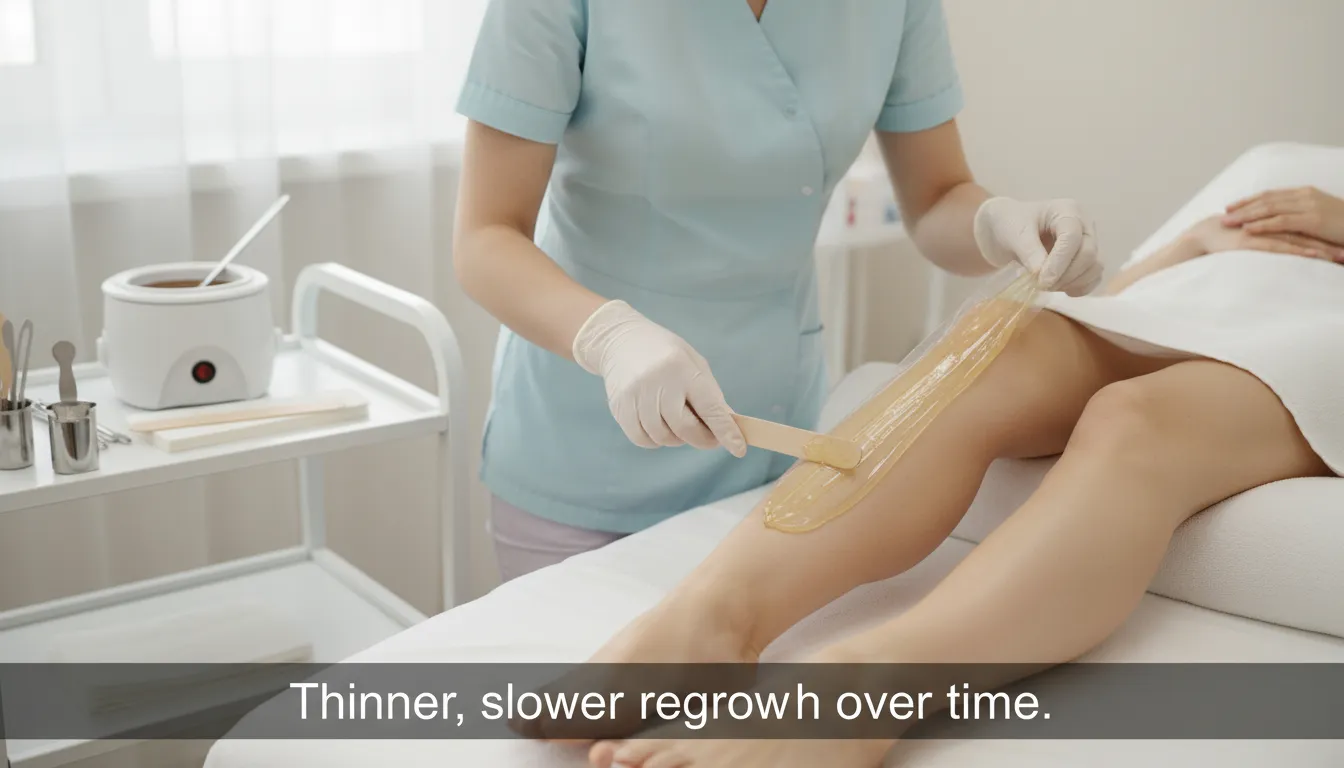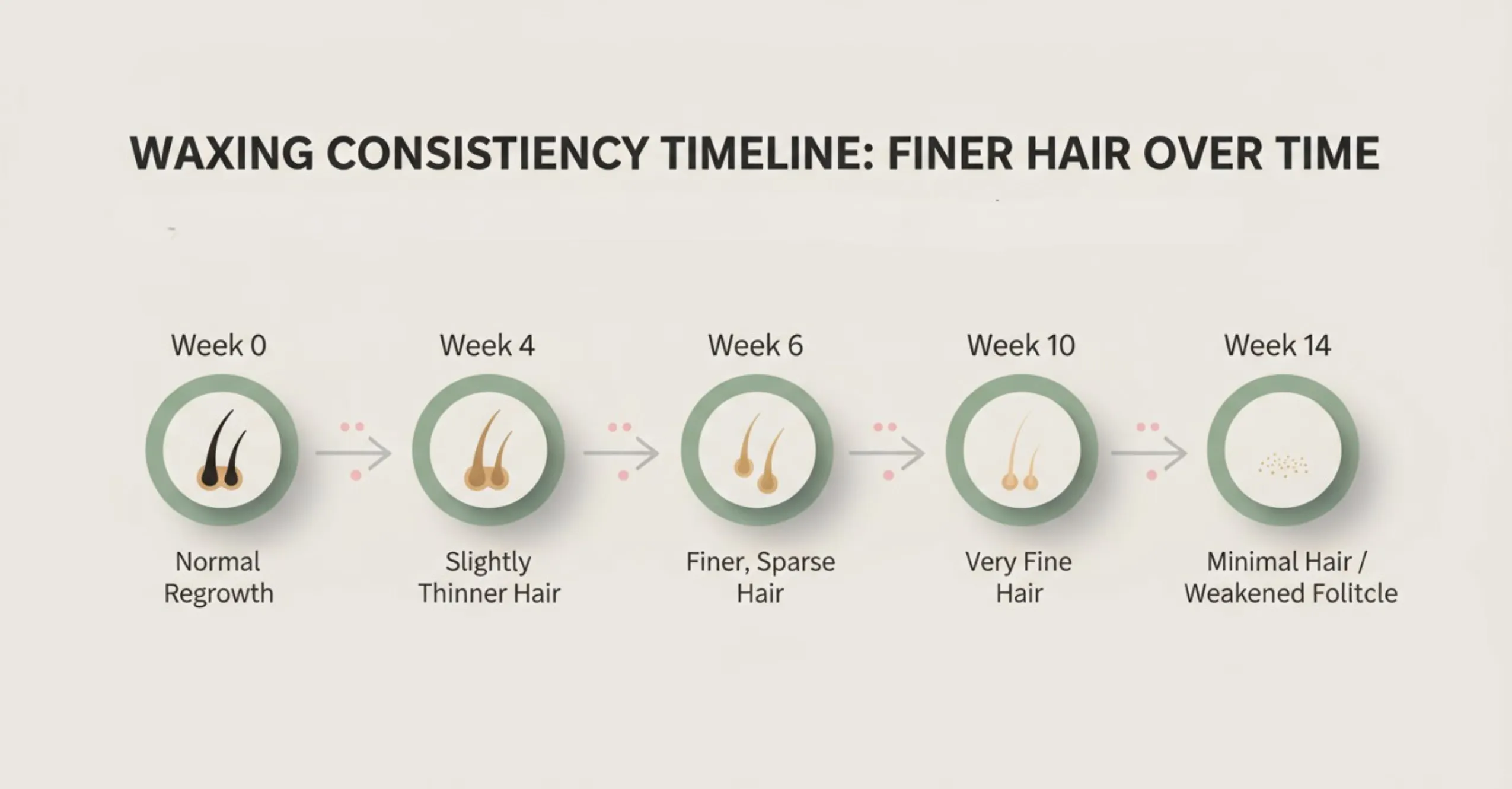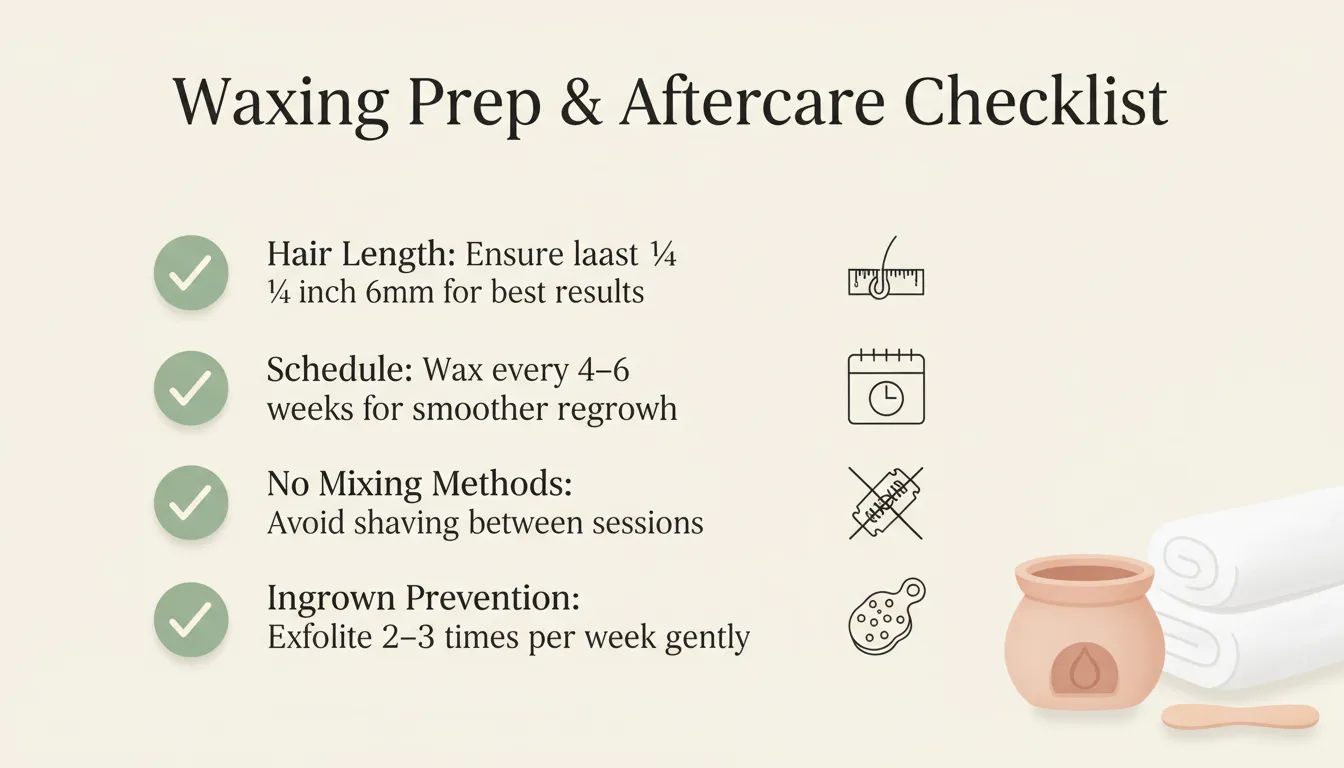
Waxing “almost” works like a permanent hair removal method if you abide by it religiously. However, many clients ask, How many times do you have to wax before hair stops growing?
Typically, there’s no set timeframe for waxing after which hair permanently stops growing. But you will notice a visible change after consistent waxing every 4-6 weeks, and the hair will grow thinner.
Desire to figure out more about this? Let’s get to the details!
How Waxing Affects Hair Growth Cycles?

Hair typically grows in four stages: anagen, catagen, telogen, and exogen. The hair growth cycle affects how quickly your hair will grow back after waxing and when you can expect a visible hair-free outcome. If you wax during the beginning of the hair growth cycle, your hair will come out in a consistent way.
Let’s learn more about hair growth phases to better understand how waxing works!
Anagen Phase
This is the growth phase of your hair, during which it grows rapidly. At this phase, the hair begins growing at the hair bulb, and sprouts out towards the direction of the mid dermis. The average rate of growth in this phase is about 1 cm every 28 days.
Catagen Phase
The catagen phase, or the regressive phase, is when your hair stops growing. In this phase, the hair shaft reaches approximately the mid-dermis. Hence, the hair turns into a club shape at the bottom and separates from the hair bulb, cutting off its source of nourishment.
Telogen Phase
This phase is known as the resting phase, during which the hair completely stops growing. In this phase, the club shape at the base of the hair shaft is fully formed. The typical length of this phase is approximately 100 days for the scalp and longer for the rest of the body.
Exogen Phase
In this phase, the hair sheds from the follicles and falls off the skin. The usual duration of this phase is two to five months at a time.
Does Waxing Stop Hair Growth? The Truth
If you need the truth on does waxing stop hair growth permanently, you need to understand that waxing reduces your hair growth with consistent sessions, but it doesn’t completely stop your hair growth. You will enjoy smooth skin for 3-6 weeks before you need another appointment.
However, if you need long-lasting results from different types of waxing, you need to stick to the routine. Don’t shave in between appointments, which will have a contradictory effect on your hair.
Nonetheless, for some people, hair can stop growing altogether, even after at least 8 months of continuous waxing. While this is an uncommon case, this mostly depends on your hair type, growth cycle, and commitment to the process.
Exactly How Many Times Do You Have to Wax Before Hair Stops Growing?
There are no certain answers to how many Brazilian waxes until hair stops growing. It depends on your hair type, the type of waxing you’re getting, and your hair growth frequency. In general, after 5-6 sessions, you will notice that your hair is growing thinner and slower than usual.
How Often to Wax by Body Area?
The hair growth pattern varies across different body areas. Let’s look at how often you need to wax based on your body areas:
| Body Area | Recommended Frequency | Expert Notes |
| Eyebrows | Every 2–3 weeks | Facial hair grows quickly, so regular maintenance keeps brows shaped and neat. |
| Upper Lip & Chin | Every 2–3 weeks | Use strip wax with a paraffin base for sensitive skin; it helps avoid irritation and effectively removes peach fuzz. |
| Face (Overall) | Every 2–3 weeks | Gentle strip wax is best for delicate facial skin. |
| Underarms | Every 2 weeks | Regrowth is noticeable quickly; hard wax is best for this sensitive area. |
| Arms | Every 3–4 weeks | Hair grows slower than facial or underarm hair; keep on a monthly schedule. |
| Armpits | Every 2 weeks | Same as underarms, maintain consistency for smoother, longer-lasting results. |
| Bikini Line | Every 2 weeks | Ideal for regular swimmers or beachgoers to stay clean and tidy. |
| Full/Brazilian Bikini | Every 3–4 weeks | Allows proper regrowth time; over time, hair becomes softer and sparser. |
| Legs | Every 3–4 weeks | Leg hair grows more slowly, so monthly waxing works best for smooth results. |
Benefits of Waxing That You Will Notice
Waxing offers so many benefits to your skin, including smooth skin, convenience, less hair growth over time, less irritation and risks of cuts or injuries, and cost savings.
- Smooth Skin: Waxing will surely give you butter-smooth skin. With religious sessions, you will experience flawless skin with hair growth reduction.
- Fast & Efficient: The whole waxing process takes only around 15 minutes. Therefore, you will get smooth skin in no time while being hair-free for a long time.
- Superior Convenience: Waxing services are super convenient and, as we already mentioned, faster than other procedures. The whole process is easier, more precise and less messy.
- Less Irritating: Epilation, razors, and hair removal creams can be harsh to your skin. Waxing, on the contrary, is less irritating, and you will get used to the process in no time.
Common Myths About Waxing and Hair Growth
Some myths around waxing confuse clients about whether to go through the process or not. Let Sugar And Wax Haven dispel some of the common myths for you:
Skin Becomes More Sensitive And Irritable After Waxing
If you’re a first timer, waxing can feel irritating and cause sensitivity. However, with time, you will be used to the process. With proper pre- and post-wax care, you can easily deal with the discomfort.
Over Waxing May Lead To Darker Skin
The optimal frequency for waxing is once a month. If you do it more frequently, it can irritate your skin and cause dark patches in certain areas. If you follow a proper waxing routine, your skin won’t get harmed; rather, it will be smoother.
Excess Waxing Can Cause A Loss Of Skin Elasticity
Sagging occurs as a result of aging, diet, and decreased collagen production. Waxing doesn’t contribute to loss of skin elasticity. With Sugar And Wax Haven waxing services, we only pull your hair during waxing, leaving your skin unharmed.
Safety Measures & Tips to Follow For Great Results
Like all beauty routines, waxing has to be done with a few safety measures in place. You need to follow safety measures, such as maintaining proper hair length, adhering to a consistent schedule, avoiding the mixing of hair removal methods, and preventing ingrown hairs, among others.
Hair Will Have to Grow to the Correct Length
If you want the best results and benefits of sugar waxing, the hair will need to grow to the right length wax will be able to remove it. If the hair is too short, the wax will not be able to grab it. If it is too long, the hair will cause the removal to be too painful. The right length will be about a quarter to half an inch.
Stick to a Steady Schedule
Not attending sessions can disrupt your hair growth pattern. Try to schedule your waxing appointments every 3–6 weeks to help your hair grow softer and more evenly.
Avoid Mixing Hair Removal Methods
Shaving and waxing are two completely different hair removal methods, and mixing them confuses your skin. Shaving only cuts the hair at the surface, while waxing pulls the hair out from the root. When you interchange the two methods, you can confuse your growth cycle.
Check for Irritation or Marks
Do not wax over cuts, rashes, or acne. Try and calm your skin before your waxing appointment. If you have a mild case of skin irritation, such as redness or tiny wounds, it’s better to rest for a few days before the appointment.
Preventing Ingrown Hairs
Taking care of your skin is especially important after waxing to minimize the risk of ingrown hairs. Every few days, gently exfoliate skin and loosen dead skin to help prevent blocked hair follicles. Apply a light soothing moisturizer to keep skin hydrated and soften skin.
When to Consider Permanent Alternatives
Waxing will give you that instant smooth feeling, but you will grow your hair back in no time. Now, let’s look at a few reasons you might consider alternatives:
When You Want Long-Term Results
For those who have dreamed of smooth skin for several months or even years, permanent options can be a lifesaver. While waxing removes the oldest hair, the roots remain untouched, allowing for rapid regrowth.
Electrolysis treatment and laser treatments are deeper, targeting and destroying the hair roots. You can achieve permanent hair freedom as hair becomes thinner, grows more slowly, or stops growing altogether.
When You’re Tired of the Routine
The constant cycle of waxing can feel exhausting. If you are tired of the sparkle on your calendar as a reminder to wax, choose a method that gives you freedom from all wax- and shave-related calendars.
When Your Skin Feels Irritated
Some skin becomes overly sensitive to the tug of waxing. If the skin irritation, allergies, bumps, or ingrown hairs, and frustration become really annoying, you might consider laser treatments and the irritation cycle that waxing triggers.
Long-Term Costs
Initially, waxing may appear to be the more affordable option. But when you look at the cost for every session over the years, the price adds up. At first, laser and electrolysis may seem expensive, but over time, they cost less and provide lasting comfort. Treat it as saving, just at a slower pace.
Frequently Asked Questions
What is the longest lasting hair removal method?
Electrolysis is the longest-lasting method since it permanently destroys the hair follicle. Laser hair removal can last up to six months and may become permanent with repeated sessions. Tweezing lasts around six to eight weeks.
At what age should you stop waxing?
There’s no age limit for waxing! With gentle technique and proper care, waxing can even make thin, delicate skin appear softer and more radiant.
How many years do you have to wax before hair stops growing?
Results differ for everyone. Some notice slower growth after six months to a year of regular waxing, while others may take longer.
Is waxing bad for mature skin?
Not at all! Mature skin just needs extra care. Use gentle wax, moisturize often, and avoid tugging too harshly. With proper technique, waxing keeps ageing skin smooth, clean, and healthy-looking.
Bottom Line
Ultimately, how many times do you have to wax before hair stops growing depends entirely on your individual hair growth and consistency. For a lasting result, choose professionals and stick to a proper routine. Soon enough, you will notice a visible change in your hair growth.




